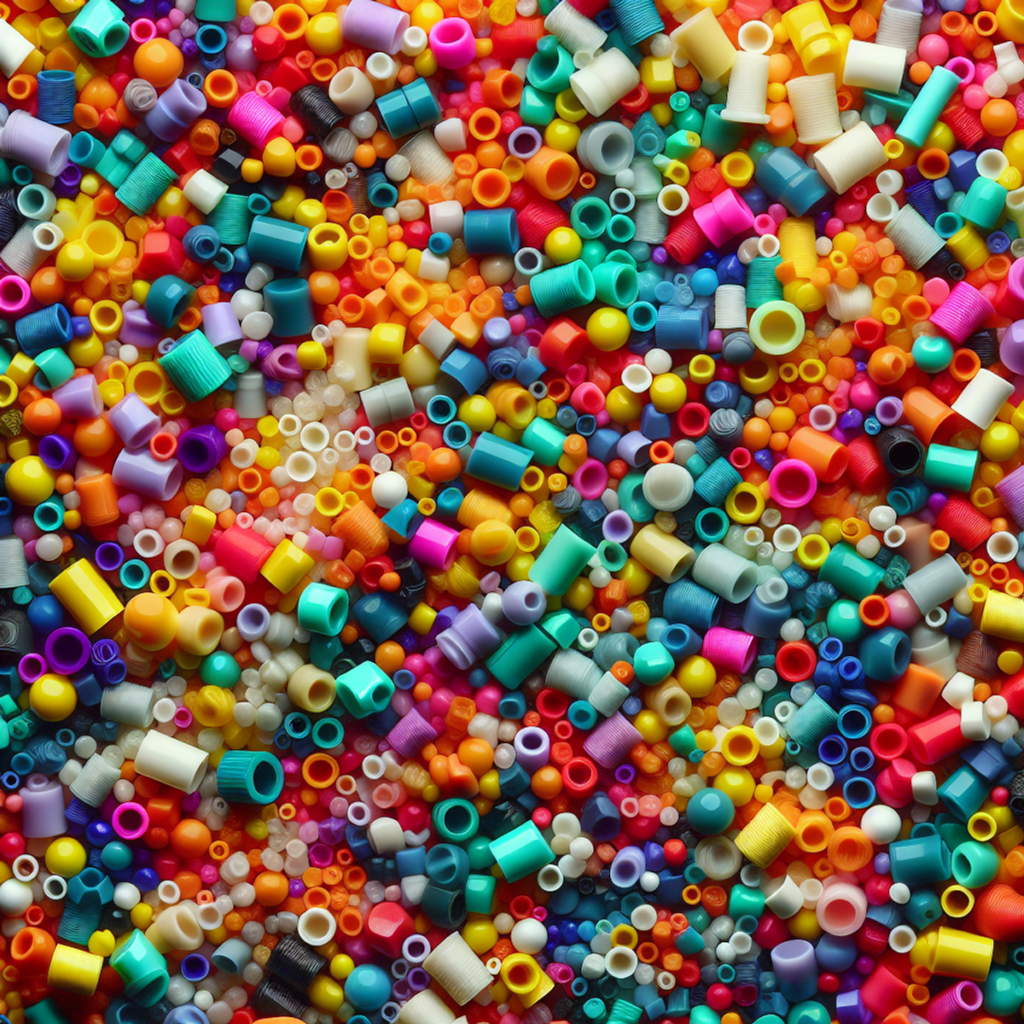Introduction to Plastic Pellet Recycling
Plastic pellets, often referred to as nurdles or resin pellets, are the raw material used in the manufacturing of plastic products. These tiny granules are the industry’s currency, melted and molded into the myriad shapes and forms that comprise the plastic items we use daily. However, despite their central role, these pellets often find their way into the environment, leading to pollution and ecological harm. As a result, there is a significant push toward recycling plastic pellets, not only to minimize environmental degradation but also to conserve resources and lessen the demand for new raw materials.
Plastic pellet recycling involves reclaiming used or waste pellets from various sources, such as industrial spillage or post-consumer products, and processing them for reuse in manufacturing. This process encompasses several steps:
- Collection: Gathering plastic pellets from both post-industrial and post-consumer avenues.
- Sorting and Cleaning: Separating the pellets by type and purity, then cleaning them to remove contaminants.
- Reprocessing: Melting down the pellets and reformulating them for further use.
- Compounding: Adding colorants or other additives necessary for the final product.
The adoption of plastic pellet recycling strategies can substantially mitigate many environmental issues associated with plastic pollution. Companies involved in the plastic supply chain, from producers to end-users, can play a pivotal role in this recycling endeavor.
Implementing an effective recycling program for plastic pellets must involve a comprehensive understanding of the material flow, the technological capabilities for processing, and the market’s requirements for recycled plastics. Stakeholders must collaborate to establish a closed-loop system that ensures maximum recovery and efficient recycling of these plastic pellets.
The Environmental Imperative for Recycling Plastic Pellets
Recycling plastic pellets is not only a matter of economic efficiency but also an environmental necessity. As the production of virgin plastics is heavily reliant on finite fossil fuel resources, the environmental cost of this dependency is significant. The manufacturing process releases large amounts of carbon dioxide, contributing to the exacerbation of climate change. Furthermore, the disposal of plastics poses a considerable problem. Often, they end up in landfills or, worse, in natural habitats where they can cause severe harm to wildlife and ecosystems.
-
Resource Conservation: By recycling plastic pellets, companies conserve valuable resources. It reduces the need for virgin plastic production, which in turn, diminishes reliance on petroleum, a non-renewable resource. This conservation is not limited to fossil fuels; water and energy savings are also significant results of recycling practices.
-
Pollution Reduction: Plastic pellet recycling significantly lessens environmental pollution. The process of recycling is generally less polluting than producing new plastics because it reduces the need for raw material extraction and processing. Furthermore, by diverting plastics from landfills and natural environments, recycling minimizes soil and water contamination, as well as wildlife disruption.
-
Mitigating Climate Change: Recycling helps mitigate climate change by reducing greenhouse gas emissions associated with plastic production. Every ton of recycled plastic pellets can significantly reduce carbon dioxide emissions compared to making the same amount of plastic from virgin materials.
-
Circulating Economy Principle: Embracing the recycling of plastic pellets encapsulates the principles of a circular economy, where products and materials are kept in use for as long as possible. This principle promotes a sustainable system that decouples growth from the consumption of finite resources, thereby fostering environmental sustainability.
Plastic pellet recycling is an integral component in the quest to preserve the planet for future generations. Stakeholders across industries have the responsibility to incorporate ethical environmental practices, including effective plastic pellet recycling strategies, into their business operations.
Understanding the Lifecycle of Plastic Pellets
Plastic pellets, also known as nurdles or resin pellets, are small granules and serve as the raw material in the fabrication of plastic products. Their lifecycle encompasses several stages, each critical to the environmental impact and the recycling potential of the material.
-
Production: The lifecycle begins with the production of plastic pellets. The process involves the polymerization of raw hydrocarbons derived from petroleum or natural gas. Pellets are typically produced in vast quantities and require significant energy and resources, highlighting the need for efficient recycling practices to minimize waste and environmental degradation.
-
Transportation: After production, pellets are transported to various manufacturing facilities. This stage is prone to spillage, with pellets often escaping into the environment and contributing to microplastic pollution. Safe and secure handling and transportation methods are imperative to prevent such losses.
-
Manufacturing: Upon arrival at manufacturing sites, pellets are melted and molded into finished plastic products ranging from packaging materials to automotive parts. This step is critical, as any defective products or excess material can be directly cycled back into the production process as recycled pellets, reducing the need for virgin material.
-
Usage: Plastic products are then distributed for consumer or industrial use. The durability and versatility of plastics lead to a wide array of applications but also pose challenges when the products reach the end of their useful life. Lifecycle analysis is essential to understand and design products for easier recyclability.
-
End-of-Life: Finally, post-consumer plastic must be managed effectively. Recycling plastic pellets at this stage involves collection, sorting, cleaning, and reprocessing into new pellets. Unfortunately, not all plastics are recycled due to contamination or economic factors, which again stresses the importance of designing for recyclability and establishing robust recycling systems.
Enhancing the recycling of plastic pellets requires an in-depth understanding of each lifecycle stage. With such knowledge, stakeholders can make informed decisions, reduce the environmental footprint, and drive the transition towards a more circular economy in the plastic industry.
Key Challenges in Plastic Pellet Recycling
Plastic pellet recycling, while increasingly recognized as crucial for environmental sustainability, confronts several significant challenges that hinder its effectiveness:
-
Contamination: One of the primary hurdles is the contamination of plastic pellets with other materials. This can occur during manufacturing, handling, or transport. Contaminants may include dirt, dust, and other types of plastic, all of which can compromise the quality of the recycled material.
-
Collection and Sorting: Effective collection and sorting systems are essential for plastic pellet recycling. Unfortunately, many regions lack the infrastructure to separate and collect these materials, particularly when they are small and easily lost in the environment. Furthermore, the need for specialized sorting technology to distinguish between different types of plastic pellets adds complexity and cost to the process.
-
Degradation: Plastics can degrade over time and with each recycling cycle. As plastic pellets are processed and recycled, their quality can diminish, limiting the number of times they can be recycled and reducing their value.
-
Economic Viability: Establishing a profitable model for plastic pellet recycling is a challenge. The costs associated with collection, sorting, and processing need to be balanced against the market value of recycled pellets. Often, the price of virgin plastics is lower than that of recycled pellets, disincentivizing investment in recycling technologies and infrastructure.
-
Regulatory Barriers: The lack of comprehensive and consistent regulations on plastic waste management and recycling can be a roadblock. Without clear standards and mandates, the voluntary nature of recycling programs leads to a disparity in recycling rates and the effectiveness of recycling systems.
-
Awareness and Education: A general lack of awareness and education about the importance and methods of plastic pellet recycling impedes widespread adoption. Stakeholders including manufacturers, handlers, and consumers, need better information to understand their role in the recycling chain and to encourage responsible behaviors.
-
Technical Limitations: Recycled pellets often do not meet the technical specifications required for certain products, which limits their use. Advances in recycling technologies and the development of new materials that blend recycled and virgin plastic are needed to overcome these limitations.
Each of these challenges represents a hurdle that must be addressed through collaborative efforts, innovation, and a commitment to sustainable practices in order to advance the potential of plastic pellet recycling.
Technological Advances in Plastic Recycling Methods
The landscape of plastic pellet recycling is evolving rapidly due to significant technological advances aimed at increasing efficiency and sustainability. Innovations in this sector target improved sorting, enhanced purification, and the creation of higher-quality recycled plastics that are competitive with virgin materials.
-
Advanced Sorting Technologies: The implementation of sophisticated sorting techniques, such as near-infrared (NIR) spectroscopy and machine learning algorithms, empowers recycling facilities to better distinguish between different types of plastics. This precision allows for more effective separation of materials, laying the groundwork for higher purity in recycling streams.
-
Chemical Recycling: Chemical recycling is emerging as a transformative approach. It breaks down plastics to their molecular components, which can then be reassembled into new, virgin-quality plastics. Techniques such as pyrolysis and gasification are spearheading this approach, presenting alternatives to traditional mechanical recycling.
-
Enzymatic Degradation: Recent research in biotechnology has led to the development of enzymes capable of degrading certain plastics such as PET. These biological catalysts aid in breaking down plastics into their original building blocks, using less energy than traditional recycling methods and offering a promising pathway to circular plastic economies.
-
Enhanced Filtration Systems: Modern filtration technologies are critical in removing contaminants from recycled plastic pellets. Breakthroughs in filtration design are enabling processors to achieve higher levels of purity, which in turn enhances the performance and aesthetics of the recycled product.
-
Blockchain for Traceability: Blockchain technology is being explored as a means of tracking recycled plastics through the supply chain. This transparency ensures that recycled materials are correctly identified and handled, which can increase trust and value in the recycled plastics market.
These advances signify a strong move towards closing the loop on plastic waste. By embracing state-of-the-art recycling technologies, the industry can not only improve the quality and efficiency of plastic pellet recycling but also pave the way towards more sustainable practices.
Best Practices in Collection and Separation of Plastic Pellets
Effective management of plastic pellets, often referred to as nurdles, is critical to recycling operations and environmental safety. To ensure the most impactful strategies, incorporating best practices in the collection and separation processes is essential.
-
Employee Training: All staff members should be thoroughly trained in proper handling techniques to minimize spillage. They should be aware of the environmental and economic impact of pellet loss and know how to manage and report spills.
-
Spill Prevention Plans: Facilities should have well-documented and accessible spill prevention plans. This includes regular maintenance of equipment and implementing containment measures to capture any loose pellets before they reach the environment.
-
Dedicated Collection Systems: Implementing systems designed for capturing, filtering, and collecting pellets at each point of transfer or processing can substantially reduce losses. This can include screens, filters, or vacuum systems designed specifically for small particulates.
-
Regular Auditing: It is important to conduct periodic audits of the collection and separation systems. These audits help identify and rectify weak points in the pellet containment process, ensuring efficiency and effectiveness are maintained.
-
Material Handling Procedures: Establishing standardized procedures for the handling and transfer of pellets can greatly reduce accidental release. This includes using appropriate containers and secure transfer methods to prevent spillage.
-
Innovative Separation Technologies: Embracing advances in separation technology can lead to more efficient and accurate sorting of plastic pellets by size, density, or type. This aids in enhancing the quality of the recycled material.
By implementing these strategies, recycling facilities can not only improve operational efficiency but also contribute to the reduction of plastic pollution. Ensuring the correct collection and separation of plastic pellets is a foundational step in maximizing the impact of plastic recycling efforts.
The Role of Government and Regulation in Promoting Plastic Pellet Recycling
Governments play a pivotal role in shaping the landscape of plastic pellet recycling through policy and regulation. By crafting laws that mandate recycling, setting targets for plastic recycling rates, or imposing taxes on virgin plastic production, governments can create a regulatory environment that encourages the reuse of materials and discourages wasteful practices.
-
Legislation and Policy Creation: Enacting legislation that supports industry-wide standards for plastic recycling helps ensure that businesses adopt sustainable practices. Governments can encourage innovation in recycling technologies by providing grants or tax incentives.
-
Extended Producer Responsibility (EPR): Imposing EPR schemes obligates manufacturers to be responsible for the entire lifecycle of their products, including post-consumer recycling. This provides a strong incentive for companies to design products that are easier to recycle and to engage in recycling activities themselves.
-
Investment in Infrastructure: Public investment in recycling facilities and advanced sorting technologies can significantly enhance the efficiency of plastic pellet recycling. Governments can provide subsidies or low-interest loans to develop the necessary infrastructure to support industry growth.
-
Public Awareness Campaigns: Governments can initiate educational campaigns to raise public awareness about the benefits of plastic pellet recycling. These campaigns can increase participation rates, improve the quality of recycled materials, and ensure a steady supply of plastic pellets for the recycling industry.
-
International Collaboration: By participating in international agreements and collaborations, governments can align their domestic policies with global efforts, fostering a cooperative approach to tackling plastic waste.
By judiciously implementing these strategies, governments can create a framework that not only encourages plastic pellet recycling but also promotes a circular economy where resources are utilized efficiently, and environmental impact is minimized. It is within the regulatory power of governments to make plastic pellet recycling not just a possibility, but a priority for a sustainable future.
Engaging the Public: Education and Participation in Recycling Programs
To enhance the efficiency and effectiveness of plastic pellet recycling, it is crucial to actively engage the public through education and participation initiatives. Understanding the life cycle of plastic and the significance of recycling can motivate individuals to make more informed choices that support sustainability efforts.
Educational Outreach: Initiatives such as workshops in schools, community centers, and online platforms can disseminate essential information about the benefits of plastic pellet recycling.
- Visually engaging materials such as infographics and videos can clarify complex recycling processes.
- Partnerships with local educational institutions can amplify the message’s reach and impact.
Incentivizing Participation: Reward systems for recycling can serve as a powerful incentive.
- Implementing a points system that allows individuals to collect rewards for recycling can encourage consistent participation.
- Local businesses may offer discounts or other benefits to customers who demonstrate their commitment to recycling.
Accessible Recycling Bins: Strategic placement of recycling bins in public spaces is necessary for convenience.
- Clearly marked bins with information about what can and cannot be recycled reduce contamination rates.
- Regular collection and maintenance of these bins are paramount to keep the public invested in the initiative.
Community Events: Hosting recycling drives and community clean-ups can foster a sense of camaraderie and collective responsibility.
- Events that focus on collecting specific types of plastics, such as plastic pellets, can educate the public on the nuances of recycling different materials.
- Recognition of participating community members or groups can provide social motivation.
Educating the public on the importance of sustainability and providing them with the tools and motivation to participate is the bedrock of any successful recycling program. Hence, leveraging education as a tool for public engagement in recycling efforts is not just a strategy but a necessity for the preservation of the environment.
Success Stories: Case Studies of Effective Plastic Pellet Recycling
The journey towards effective plastic pellet recycling is paved with numerous success stories, demonstrating the immense potential and tangible benefits of mastering this process.
-
Circular Economy Champion: Precious Plastic
Precious Plastic, a global community-driven project, stands as a beacon of sustainability. By providing open-source blueprints for recycling machines, they empower local communities to turn waste into valuable products. Their success is evident in the proliferation of micro-recycling plants worldwide, showing that decentralized and community-focused initiatives can have a significant impact. -
Corporate Initiative: The NexTrex® Recycling Program
A noteworthy corporate example is the NexTrex® Recycling Program, which collaborates with retailers and consumers to collect and recycle plastic film. Their innovative platform ensures that millions of pounds of plastic waste are converted into eco-friendly decking and railing products every year, showcasing a profitable business model tied to effective recycling practices. -
Government-Led Accomplishment: Japan’s Plastic Recycling Model
Japan stands out as a government-led success story, achieving one of the highest plastic recycling rates in the world. Their meticulous sorting guidelines and advanced technology have enabled them to efficiently recycle plastic pellets, effectively reducing environmental waste and conserving resources. -
Educational Impact: The Ocean Cleanup Project
A significant educational case study is The Ocean Cleanup Project. While their primary objective is to remove plastics from oceans, they also focus on recycling the collected material into new products. Their efforts have not only raised awareness about pollution but also showcased how recycled plastics can be integrated back into the economy.
These case studies reflect the dynamic nature of the recycling industry, illustrating how creative thinking and collaborative efforts across sectors can lead to successful plastic pellet recycling, thereby contributing to a more sustainable future.
Innovations in Plastic Pellet Reuse and Upcycling
The landscape of plastic pellet recycling is experiencing a surge in innovative practices that aim to enhance sustainability and efficiency. These innovations span various processes, right from collection to the transformation of plastic pellets into valuable products.
-
Chemical Recycling: Pioneering a transformation in pellet reuse, chemical recycling breaks down plastics to their molecular level, allowing the creation of virgin-quality plastics or other chemical products. Companies are investing in this technology to process mixed or contaminated plastics that mechanical recycling cannot handle.
-
Advanced Sorting Technologies: Innovations in sorting technologies, such as AI-driven robotic systems and spectroscopy, provide more precise separation of plastic pellets by type and color. This level of granularity optimizes the quality of the recycled product.
-
Biodegradable Alternatives: Research continues into developing biodegradable plastic pellets, which promise an upcycled life beyond traditional reuse. These bioplastics aim to decompose under specific conditions, reducing long-term environmental impact.
-
3D Printing Feedstock: Upcycling plastics into feedstock for 3D printing offers a lucrative path for pellet reuse. This process turns recycled pellets into filaments, which are then used in 3D printers to create objects ranging from industrial components to creative consumer products.
-
Circular Economy Models: Companies are inventing circular economy business models, where plastic pellets are continuously cycled back into the production stream. By designing products with recycling in mind, companies can ensure that plastic pellets are more easily reintroduced into the manufacturing process.
Through these innovative strategies, industry players are not only diverting plastic pellets from landfills but are also adding value to the environmental supply chain. The potential for these technologies and approaches to reshape the future of plastic pellet recycling carries significant implications for sustainability and resource utilization.
Building Effective Partnerships Across the Plastic Recycling Chain
Establishing productive collaborations is crucial to the success of plastic pellet recycling. Constructing a robust network that includes manufacturers, consumers, recyclers, and policymakers ensures a seamless plastic recycling process. To build effective partnerships, it is necessary to:
-
Identify key stakeholders in the plastic recycling chain, including plastic waste generators, collection agencies, sorting facilities, processing plants, and end-users of recycled pellets. Engage with these entities to align goals and create a mutual understanding of the benefits of recycling plastic pellets.
-
Foster open communication channels among all partners to facilitate the exchange of information on challenges, innovations, and best practices in plastic recycling. Regular meetings and workshops can serve as platforms for stakeholders to share knowledge and experiences.
-
Implement standard operating procedures (SOPs) and certifications, such as the Global Recycle Standard (GRS), across the recycling chain to ensure quality and consistency of the recycled pellets. These standards maintain the integrity of the recycled material, making it a reliable raw material for manufacturers.
-
Develop economic incentives to encourage stakeholders’ participation in recycling initiatives. These can include tax benefits, subsidies, or preferential pricing for companies that use recycled plastic pellets in their production processes.
-
Invest in joint research and development efforts to improve recycling technologies and create innovative approaches to recycling different types of plastics. Collaboration between industry and academic institutions can yield breakthroughs that benefit the entire recycling chain.
-
Promote transparency by tracking and reporting the flow and impact of recycled plastics. Transparency tools, such as blockchain or other traceability software, can provide assurances about the origin and quality of recycled materials.
Creating strategic partnerships among the various players in the plastic recycling ecosystem is fundamental to enhancing the efficiency and effectiveness of plastic pellet recycling. By working together, stakeholders can create a more sustainable future that maximizes the value of plastics and minimizes environmental impact.
The Future of Plastic Pellet Recycling: Trends and Predictions
Innovations in the plastic recycling industry are continually shaping the future of plastic pellet recycling, driven by technology, policy, and consumer behavior. The following trends and predictions are expected to influence this evolving landscape:
- Advanced Sorting Technologies: Sophisticated sorting systems utilizing artificial intelligence, robotics, and machine learning will become more prevalent, enhancing efficiency and purity in plastic pellet recycling.
- Chemical Recycling Growth: Chemical recycling, which breaks down plastics to their molecular components, is predicted to gain momentum, complementing traditional mechanical recycling methods and handling plastics that are currently non-recyclable.
- Biodegradable Alternatives: The development of biodegradable plastic pellets may increase as a response to environmental concerns, potentially altering recycling paradigms.
- Circular Economy Integration: Recycling systems are anticipated to be fully integrated into circular economy principles, emphasizing product design for recyclability, extended producer responsibility, and waste reduction.
- Regulatory Shifts: Anticipate tighter regulations on plastic usage and waste management, which could drive innovation and adoption of recycling technologies.
- Sustainable Business Models: Business models that rely on sustainable practices, such as plastic-as-a-service where producers retain ownership of plastics, could reshape industry norms.
- Consumer Engagement: Increased public awareness and consumer demand for sustainable products are likely to pressure businesses to adopt more responsible recycling practices.
These directions point toward a future where plastic pellet recycling is more efficient, innovative, and aligned with global sustainability goals. The successful integration of these trends will require collaboration among industry stakeholders, governments, and consumers.
Call to Action: How Companies and Individuals Can Make a Difference
With rising awareness of the environmental impact of plastic pellet pollution, both companies and individuals possess the capability to engender significant positive change through the implementation of effective plastic pellet recycling strategies. Here are actionable steps to consider:
For Companies:
- Implement a Closed-Loop System: Establish a system where plastic pellets are continuously recycled within the manufacturing process, reducing the need for virgin materials.
- Invest in Cutting-Edge Recycling Technologies: Allocating funds toward advanced sorting and recycling technologies can enhance the efficiency and effectiveness of recycling programs.
- Adopt Pellet Loss Prevention Measures: Implement best practices such as spill containment systems and routine clean-up operations to minimize pellet loss during production and transportation.
- Educate Employees: Conduct regular training sessions to raise awareness among staff about the importance of proper pellet handling and waste management protocols.
- Partner with Environmental Organizations: Collaborate with non-profits and environmental agencies to amplify recycling efforts and participate in community clean-up initiatives.
For Individuals:
- Support Responsible Companies: Purchase products from companies with strong environmental commitments and transparent recycling policies.
- Advocate for Change: Use social media platforms to call for better corporate responsibility and encourage government policy that favors sustainable practices.
- Volunteer for Clean-Ups: Join local beach or river cleanup events to help remove plastic pellets and other pollutants from the environment.
- Educate Others: Share information about the importance of plastic pellet recycling with your community, perhaps through local clubs or online forums.
- Reduce, Reuse, Recycle: Make mindful buying choices, opt for products with less packaging, and ensure proper sorting of recyclable materials in your household.
By taking proactive measures, companies can reduce their environmental footprint, while individuals can contribute to a wider culture of sustainability. The collective effort will propel us towards a future where plastic pellet recycling is not just a strategy, but a standard practice, leading to a cleaner and healthier planet for all.
Conclusion: Moving Towards a Sustainable Model for Plastic Use and Recycling
Aligning with environmental imperatives necessitates a transformation in our approach to plastic use and recycling. Establishing a sustainable model demands concerted effort across multiple areas:
-
Recycling Infrastructure: Enhancements in recycling infrastructure are crucial. Facilities must be equipped to sort, clean, and process a wider range of plastic pellets. Investment in state-of-the-art equipment and technology can drive efficiency and improve the quality of recycled plastics.
-
Legislative Frameworks: Governments must create robust policies that foster industry compliance and support circular economy initiatives. Incentives for utilizing recycled materials and penalties for unsustainable practices can motivate significant change.
-
Innovation in Material Design: Pivoting towards design-for-recyclability from the outset is fundamental. Producers can re-engineer products to minimize complexity and enhance the recyclability of plastic components.
-
Consumer Education: Educating consumers about the recycling process and the importance of proper disposal can lead to better recycling rates. Awareness campaigns must underscore the critical role each individual plays in the recycling ecosystem.
-
Corporate Responsibility: Businesses bear responsibility to adopt sustainable practices, procure responsibly, and minimize waste. Internal policies can prioritize recycled materials and circularity principles.
-
Global Collaboration: No entity can attain sustainability in isolation. International cooperation allows for sharing best practices, harmonizing standards, and tackling the plastic waste challenge collectively.
The path towards a sustainable plastic economy is a multifaceted endeavor. By integrating these strategies, stakeholders from governments to individual consumers can contribute to a viable plastic use and recycling model that aligns with sustainability goals. Balancing the need for plastics in modern society with ecological concerns is not only possible but essential for the preservation of our planet.






